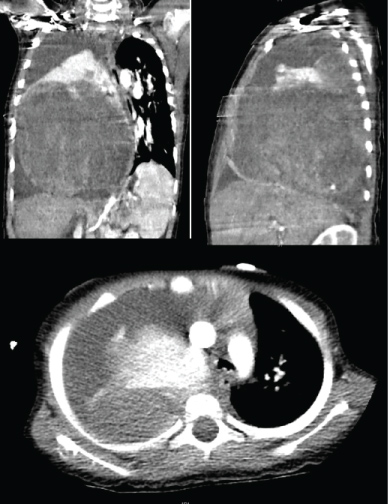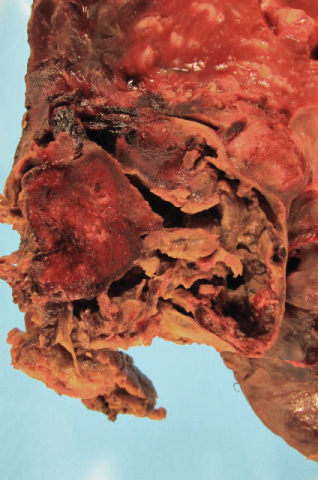Pleuropulmonary Blastoma is a Rare and Deadly Tumor in Pediatric Population
Pleuropulmonary blastoma (PPB) is a rare mesenchymal tumor that often involves the lung. Between 25 to 50 children are diagnosed with PPB annually in the United States [1-3]. PPB is the most common primary lung cancer of childhood [4]. The mean age at diagnosis is between 2 to 5 years with no predilection for gender [5]. There are three types of PPB [6-8]. Type I is the least common with the best prognosis [6,7,9-11]. It occurs in less than 15% of all PPBs. It typically affects children less than one-year-old with a median age of 10 months. Gross pathology is characterized by cystic or multi-cystic components. Type II PPB occurs in 40% to 50% of all PPBs, affecting older children with a median age of 34 months and characterized by mixed cystic and solid patterns with thickened nodules within cystic lesions [12-14]. Type III PPB typically affects older children over the age of 44 months [15]. Its gross pathology is characterized by a solid, white mucoid mass that is necrotic, calcified, and friable. PPB has been known to progress from one type to another over time [16].
The tumor is composed of malignant mesenchymal cells which may be primitive blastema cells or large malignant sarcoma type cells. The epithelial component is typically benign. These cells are positive for vimentin and may also be positive for desmin and myogenin [16].
Familial PPB is associated with a germline mutation in the DICER1 gene which encodes an enzyme required for the production of mature microRNAs [3,17,18]. PPB is genetically associated in approximately 70% of cases [19]. Family tumor and dysplasia syndrome includes PPB, pulmonary cysts, cystic nephroma, soft tissue sarcomas, nasal chondromesenchymal hamartoma, nodular hyperplasia, carcinoma of the thyroid gland, and ovarian sex chord stromal tumors [17]. Strong suspicion needs to exist in lieu of diagnosis of a DICER1 mutation in family members as there is a 50% chance of inheriting the same mutation. Primary ovarian neoplasms are often manifested as familial PPB syndrome and are often the initial clinical presentation of DICER1 mutations within a family [17].
The diagnosis of pleuropulmonary blastoma in a child with family history of bilateral Sertoli-Leydig ovarian tumors and papillary thyroid cancer is an unusual finding and warrants investigation for a genetic correlation of a DICER1 mutation.
High suspicion of a familial PPB promotes early recognition of tumors in a predisposed child or family member allowing for early treatment and better outcomes. It is imperative that children with recurrent pulmonary symptoms be evaluated with high suspicion for this tumor and family history be obtained.
Furthermore, if a mutation in DICER 1 is found, all family members must be screened to catch the disease process early on as it is of autosomal dominant inheritance. The overall survival rate of this tumor is hard to estimate due to the rare nature of this disease.
References
- Fosdal MB (2008) Pleuropulmonary blastoma. Journal of Pediatric Oncology Nursing 25: 295-302.
- Gutweiler JR, Labelle J, Suh MY, et al. (2008) A familial case of pleuropulmonary blastoma. Eur J Pediatr 18: 192-194.
- Hill DA, Ivanovich J, Priest JR, et al. (2009) DICER1 mutations in familial pleuropulmonary blastoma. Science 325: 965.
- Chakraborty J, Sanyal S, Biswas S, et al. (2004) Pleuropulmonary blastoma--a rare pathology. Indian J Pathol Microbiol 47: 215-217.
- Anand R, Narula MK, Chadha R, et al. (2013) Pleuropulmonary blastoma. J Indian Med Assoc 111: 128-129.
- Shivastava R, Saha A, Mehera B, et al. (2007) Pleuropulmonary blastoma: Transition from type I (cystic) to type III (solid). Singapore Med J 48: e190-e192.
- Herman TE, Siegel MJ (2008) Neonatal pleuropulmonary blastoma, type 1. Journal of Perinatology 28: 82-84.
- Hill DA, Jarzembowski JA, Priest JR, et al. (2008) Type I pleuropulmonary blastoma: Pathology and biology study of 51 cases from the international pleuropulmonary blastoma registry. Am J Surg Pathol 32: 282-295.
- Walsh S, Wood AE, Greally P (2009) Pleuropulmonary blastoma type I following resection of incidentally found congenital lobar emphysema. Ir Med J 102: 230.
- Lezmi G, Verkarre V, Khen-Dunlop N, et al. (2013) FGF10 Signaling differences between type I pleuropulmonary blastoma and congenital cystic adenomatoid malformation. Orphanet J Rare Dis 8: 130.
- Fingeret A, Garcia A, Borczuk AC, et al. (2014) Thoracoscopic lobectomy for type I pleuropulmonary blastoma in an infant. Pediatr Surg Int 30: 239-242.
- Vargas SO, Korpershoek E, Kozakewich HP, et al. (2006) Cytogenetic and p53 profiles in congenital cystic adenomatoid malformation: Insights into its relationship with pleuropulmonary blastoma. Pediatr Dev Pathol 9: 190-195.
- Corapcioglu F, Liman T, Aksu G, et al. (2009) A case report with type II pleuropulmonary blastoma: Successful treatment with surgery and chemotherapy. Turk J Pediatr 51: 78-81.
- Yu L, Cheng H, Yang SJ (2014) Clinicopathological and extensive immunohistochemical study of a type II pleuropulmonary blastoma. Fetal Pediatr Pathol 33: 1-8.
- Marcano L, Naranjo A, Cabrera Y, et al. (2014) Pleuropulmonary blastoma type III extended into the left atrium in a 16-month old boy. European Journal of Cardio-Thoracic Surgery 45: e173-e175.
- Husain AN (2012) High-Yield Thoracic Pathology, 38-40.
- Schultz KA, Pacheco MC, Yang J, et al. (2011) Ovarian sex cord-stromal tumors, pleuropulmonary blastoma and DICER1 mutations: A report from the International Pleuropulmonary Blastoma Registry. Gynecol Oncol 122: 246-250.
- de Kock L, Plourde F, Carter MT, et al. (2013) Germ-line and somatic DICER1 mutations in a pleuropulmonary blastoma. Pediatr Blood Cancer 60: 2091-2092.
- Manivel JC, Priest JR, Watterson J, et al. (1988) Pleuropulmonary blastoma. The so-called pulmonary blastoma of childhood. Cancer 62: 1516-1526.
Corresponding Author
Yana Puckett, MD, MPH, MBA, MSc, Department of General Surgery, Texas Tech University Health Sciences Center, 3601 4th Street Stop 8302, Lubbock, TX 79430, USA.
Copyright
© 2018 Puckett Y. This is an open-access article distributed under the terms of the Creative Commons Attribution License, which permits unrestricted use, distribution, and reproduction in any medium, provided the original author and source are credited.






